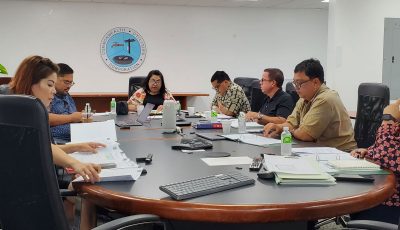CUC oil pipeline, Tank 102 projects formally opened
Starting with an original $2M budget, pipeline ended up into $14M project

Gov. Ralph DLG. Torres, center, and Commonwealth Utilities Corp. board chair Adelina C. Roberto, fourth from left, led the ribbon-cutting ceremony for CUC pipeline and Tank 102 replacement projects at CUC Power Plant in Lower Base on Friday afternoon. From left, Capital Improvement Project administrator Virginia Villagomez, Rep. Antonio Sablan (Ind-Saipan), CUC acting executive director Gary Camacho, Roberto, Torres, U.S. Department of the Interior grants management specialist Keith Aughenbaugh, U.S. District Court for the NMI Chief Judge Ramona V. Manglona, Tano Group’s Robert Bracken, and Rep. Joseph Leepan Guerrero (R-Saipan). (Ferdie de la Torre)
Gov. Ralph DLG Torres and Commonwealth Utilities Corp. officials led on Friday the ribbon cutting for the completed controversial Commonwealth Utilities Corp.’s new oil pipeline that began only with a $2-million budget in 2011 and ended up a $14-million project due to complexities.
With the takeover of the federal court-appointed Engineering Environmental Management Company (EEMC) Gilbane Federal, the pipeline construction was completed only in an approximate six-month timeframe beginning in November 2015.
Aside from the pipeline project, Torres and CUC officials also held the simultaneous ribbon cutting for CUC’s Tank 102 replacement project in Lower Base.
The old oil pipeline was an 8-inch aboveground receiving pipeline that delivered diesel fuel from the Mobil oil facility to CUC Power Plants 1 and 2 in Lower Base. The U.S. Environmental Protection Agency had stated that until the pipeline is properly repaired or replaced, it poses a threat to the adjacent ocean.
Tank 102 project involves a 500,000-gallon diesel fuel tank that replaced Tank 010, which has been found to be a source of pollution and is non-repairable.
In his special remarks, Torres said CUC has always been a sensitive topic.
Torres said people in the CNMI would not survive without CUC.
“Here we are, five years later addressing our pipeline. This is one of the stipulation orders that has been addressed,” Torres said.
Torres said there was a time when people felt that the government and CUC were not doing anything about the pipeline, but that a lot of paperwork has to be done.
The governor congratulated the CUC team, the executive director, the board, the Capital Improvement Project, and all the engineers that have worked hard for these projects.
Torres said the government and CUC still have a long way ahead to address CUC issues, but this pipeline project is definitely one that is very critical part in addressing the stipulation orders.
“That’s one off the book and there’s a couple more that we need to focus again,” Torres said.
The governor asked for the continued support from everyone by giving solutions to CUC and the government to help them move forward on other projects so that they can assist these court-ordered stipulations 1 and 2.
CUC acting executive director Gary Camacho said the two projects are five-year programs in tandem with federal agencies—the U.S. Department of Justice and Environmental Protection Agency—and local agencies.
“It was trying at a time during the five years but there was something certain—nobody wavered on their effort and commitment to complete these,” Camacho said.
Camacho said with the completion of the pipeline and Tank 102, CUC now has a better program, more capable to providing reliable power and indeed having a system that protects from oil leaks into the environment.
He noted that there’s a lot of dedication and commitment from a lot of people to complete the projects.
Camacho said U.S. District Court for the NMI designated Judge David O. Carter knew what he wanted and he knew what he expected from this pipeline project.
Carter was not present at the ceremony, but U.S. District Court for the NMI Chief Judge Ramona V. Manglona participated in the ribbon cutting.
Camacho said Tank 102 adds additional fuel storage capability.
U.S. Department of the Interior grants management specialist CUC’s technical manager for oil Max Simian acknowledged the long process and many years of efforts of many people, local, and federal agencies involved in the projects.
Simian said both the tank and the pipeline are more than five years long in the making.
“Frankly at times, it looked like it would never finish but it has,” he said.
Simian pointed out that both the tank and the pipeline are built to full industry standards as well as federal regulations.
“This is the first for CUC and the CNMI,” he noted.
CUC board chair Adelina C. Roberto said it’s a long one-mile pipeline and probably the longest ever built one-mile pipeline.
U.S. Department of the Interior grants management specialist Keith Aughenbaugh said they are very happy that they were able to fund the projects.
“It’s been about a five-year project,” he noted.
Aughenbaugh said for most of the tank and the underground pipeline, there had been a few false starts and it’s taking some redesign work and some reconstruction.
“But overall we’re quite happy and glad that OIA could provide some of the funding for the projects,” he said in an interview.
Aughenbaugh said the pipeline started in 2011 as a $2-million project and that because of some redesigns and bringing in additional contractor and then of course the EEMC firm Gilbane Federal was brought in about a year ago.
He said it’s through EEMC’s efforts that CUC was able to finish both projects.
He said the pipeline’s total funding was about $14 million, including the $2 million in original funding.
Aughenbaugh said Tank 102 is half a million project, federally funded.
He said Tank 102 had to be rebuilt as there was a problem with the building.
He said a couple of years ago, it was being built, but there was a problem with the welding.
“So they did have to tear it apart and start all over,” the DOI official said.
Aughenbaugh said it’s a joint venture expenditure authority between the governor’s office and CUC to get these two projects completed.
“It looks great. The project is very good. I’m just happy to still be involved with the CIP projects program on behalf of the OIA,” Aughenbaugh said.
Tano Group is the sub-contractor for the pipeline project and the general contractor for the Tank 102. The company completed the projects in six months.
Tano Group’s Robert Bracken said they have been working with CUC for 20 years or longer now.
Bracken said it’s the second time they re-built Tank 102 since they built it in 1992.
He said they actually repaired it and it’s not in service for five years as they locked it down.
Bracken said CUC has a great team and has such a really good workforce.
Bracken praised CUC foreign workers who have been working with Tano Group for 20 years.
“It’s an honor to build this tank once again,” Bracken said.
Running CUC into ground
Former CUC chief financial officer Matt Yaquinto told Saipan Tribune yesterday that CUC gets a new pipeline that cost over $14 million or more than the Keystone Pipeline per foot.
Yaquinto said CUC could have repaired the old pipeline for around $1.5 million.
Yaquinto said the rest of CUC is collapsing, as it is being run into the ground by the board, the acting management, and all the while the stipulated order positions, who are professionals that know how to run a utility, are all being terminated
Due to unforeseen site conditions and construction challenges encountered that include human remains exhumations, additional archeological excavations, an unexploded 500-lb World War II bomb, among others, CUC’s oil pipeline construction project’s cost increased by $2.1 million from the $8.5-million budget ceiling under EEMC.



























